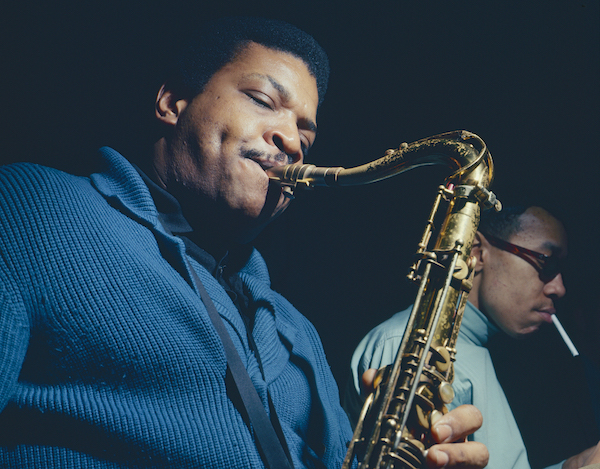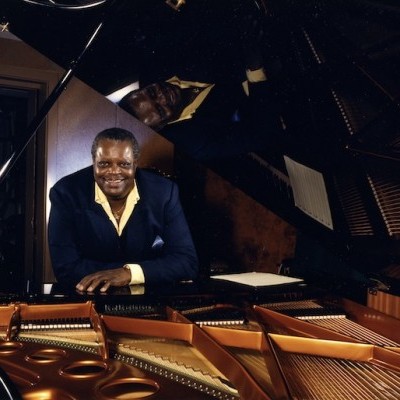Dec 9, 2025 12:28 PM
In Memoriam: Gordon Goodwin, 1954–2025
Gordon Goodwin, an award-winning saxophonist, pianist, bandleader, composer and arranger, died Dec. 8 in Los Angeles.…

The George Coleman Quintet In Baltimore, a concert recording from 1971, is in essence a blowing session helmed by the saxophonist.
(Photo: Courtesy DL Media)In 1971, George Coleman was seven years removed from the most sought-after gig in jazz: a spot in Miles Davis’ band, where the tenor saxophonist had been the trumpeter’s frontline partner. It had by then been the launchpad for a number of major careers, including those of Coleman’s former bandmates—pianist Herbie Hancock, bassist Ron Carter and drummer Tony Williams. Coleman, on the other hand, still was mostly a sideman.
“I was basically just freelancing,” the 85-year-old remembered recently. “I would always have some kind of gig somewhere. I was in Clark Terry’s big band, in Slide Hampton’s band and was working with Elvin Jones and Harold Mabern.” He was doing fine: He made a living with those leaders, touring the States and Europe, while his own bands—quartet, quintet and octet—also were getting work in New York. Yet, Coleman hadn’t quite gained the kind of cache that his resume had augured. Indeed, it would be another six years before he released an album under his own name.
They knew him in Baltimore, though. The Left Bank Jazz Society—an organization that presented jazz every week at the Famous Ballroom on Charm City’s east side—brought Coleman down about once a month. Often, he was there with someone else’s band: a 1968 recording has been issued with him behind Wynton Kelly, and a 1970 album finds the saxophonist accompanying drummer Roy Brooks. But on May 23, 1971, Coleman was leading a zesty quintet with trumpeter Danny Moore, pianist Albert Dailey, bassist Larry Ridley and drummer Harold White. Now out as The George Coleman Quintet In Baltimore (Reel to Real), the performance is the earliest available recording of Coleman as a bandleader.
“I was very much surprised,” said Coleman of the tapes, made by Left Bank honcho Vernon Welsh. “I knew they were recording, but I never knew how it came out. The stuff that they recorded came off pretty damn good.”
The Sunday afternoon concert featured five standards, two from the Great American Songbook and three bebop tunes. In essence, it was a blowing session. “You could call it a pickup band,” Coleman said. “We hadn’t rehearsed or anything; there was nothing written down. We just got up and played. I called the tunes, and the counterpoint lines and harmonies were spontaneous.”
There is only one real appearance of counterpoint: In the set opener, John Lewis’ “Afternoon In Paris.” The lines that Coleman and Moore play are reminiscent of J.J. Johnson’s 1949 recording (also arranged by Lewis), but with a looseness and rawness that does sound quite in the moment. Undoubtedly, the musicians knew Johnson’s record, but their ability to call up its interacting lines on a dime also is a testament to their high-caliber musicianship.
“The guys I was playing with, they knew what to do,” Coleman said.
This kind of ad hoc approach is, of course, a jazz staple. It also seems to have been a frequent arrangement for the saxophonist at the time. Certainly, the set was common enough that, until the recording jogged his memory, this 1971 performance didn’t stick out for the bandleader.
“If you’d have said to me, ‘Remember that date in Baltimore?’ I’d have said no, I didn’t,” he posited. “I couldn’t have told you the personnel and I didn’t remember recording it. But I remember playing, and I remember that the guys who were with me sounded wonderful. But I didn’t know they sounded that good, man. That made it really enjoyable to hear it 50 years down the road. I said, ‘Damn, we did that?’”
More generally, Coleman has vivid memories of playing in Baltimore, and especially of playing under the auspices of the Left Bank Jazz Society, which ran from 1964 into the 1990s.
“It was a nice organization,” he said. “They had jazz every week, every Sunday, that they would bring all kinds of musicians to the Famous Ballroom and all kinds of people would come out on those Sundays. The people in Baltimore, they were real jazz fans. They really loved it.” Importantly, the Famous Ballroom—whose location now belongs to the historic Charles Theatre—was integrated. “There were always a lot of Black people, too,” Coleman said. “You don’t see a lot of black people today at jazz gatherings.”
In that sense, In Baltimore also is a document of the city’s history—one that is now long gone, with a barebones jazz infrastructure further weakened by the pandemic’s devastation. Primarily, though, it’s Coleman’s career that the album illuminates, showing that the saxophonist’s chops, resources and confidence were ready for prime time well before most of the jazz world knew it.
Hearing how good he and the band sounded, though, is somewhat bittersweet for the saxophonist. “It was a good time. It’s fond memories,” he said. “My life has been pretty good. But Al Dailey, Harold White, they’ve passed on. Larry Ridley is the only one left from that date. Everybody’s gone, man. I’m thankful for being on the planet as long as I’ve been. But I don’t dwell on it, because every time I look up, I see one of my friends and fellow musicians is gone.”
The music, however, remains, as fresh and exciting as it was 50 years ago. DB

Goodwin was one of the most acclaimed, successful and influential jazz musicians of his generation.
Dec 9, 2025 12:28 PM
Gordon Goodwin, an award-winning saxophonist, pianist, bandleader, composer and arranger, died Dec. 8 in Los Angeles.…

Nov 13, 2025 10:00 AM
For results of DownBeat’s 90th Annual Readers Poll, complete with feature articles from our December 2025 issue,…

Flea has returned to his first instrument — the trumpet — and assembled a dream band of jazz musicians to record a new album.
Dec 2, 2025 2:01 AM
After a nearly five-decade career as one of his generation’s defining rock bassists, Flea has returned to his first…

To see the complete list of nominations for the 2026 Grammy Awards, go to grammy.com.
Nov 11, 2025 12:35 PM
The nominations for the 2026 Grammy Awards are in, with plenty to smile about for the worlds of jazz, blues and beyond.…

“It’s a pleasure and an honor to interpret the music of Oscar Peterson in his native city,” said Jim Doxas in regard to celebrating the Canadian legend. “He traveled the world, but never forgot Montreal.”
Nov 18, 2025 12:16 PM
In the pantheon of jazz luminaries, few shine as brightly, or swing as hard, as Oscar Peterson. A century ago, a…